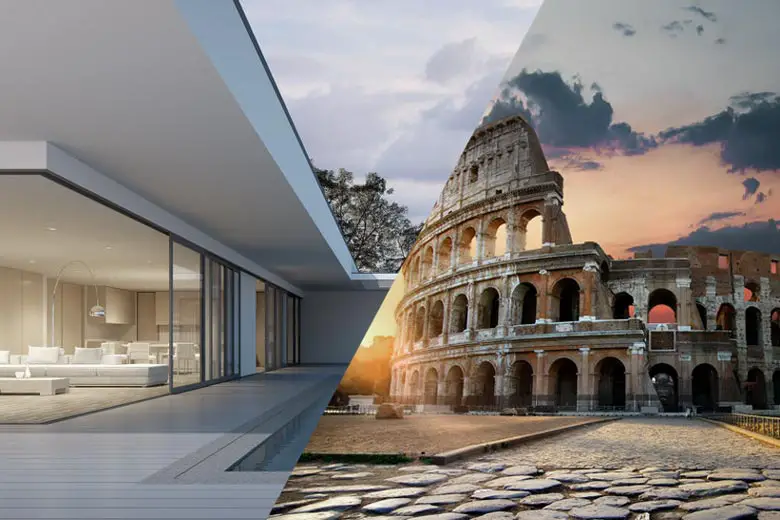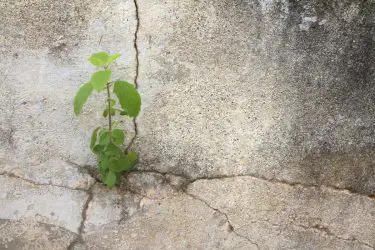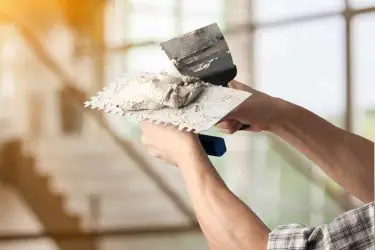Modern concrete differs from the concrete used in the past. In ancient Rome, the Romans used concrete to build an array of structures—with some so big and majestic, leading many to wonder how the Romans made them. However, the concrete we use today isn’t the same; this begs the question: which variety of concrete is more robust and durable, old or new concrete?
Old concrete is stronger than new concrete. The Roman Empire used old concrete to build walls and structures that still stand today. New concrete buildings don’t last for anywhere near as long as buildings made using old concrete. Today’s concrete can typically last for 100 years only.
Keep reading for an in-depth look into the differences between old and new concrete. I’ll explore what makes Roman concrete so durable and why it’s not currently used today. Also, I’ll delve into the advantages and disadvantages of both old and modern concrete.

Table of Contents
Why Is Old Concrete Stronger Than New Concrete?
Old concrete can withstand more wear and tear than modern alternatives. It can even resist the full force of the sea for thousands of years without deterioration. So what makes old concrete so resilient and durable even after such a long period in harsh conditions?
Old concrete is stronger than new concrete because old concrete contains rare minerals like Al-tobermorite and phillipsite. These minerals cure the old concrete continuously. As a result, old concrete gets stronger over time, making it more durable and robust than new concrete.
A mixture of volcanic rock and lime formed old concrete. This mixture was ground up and set using wooden frames. The mixture was then exposed to seawater which triggered a hot chemical reaction. This reaction caused the concrete to cure and form intense bonds.
The rare minerals in old concrete form tight bonds with the volcanic rock or ash during the curing process. These minerals form into crystals during curing—they have a similar shape and strength to volcanic rock. As a result, the concrete hardens into a solid structure capable of withstanding more wear.
Since seawater was used to cure old concrete, you’ll regularly find Roman concrete that still stands today in sea walls. These seawalls continue to get stronger over time as the seawater strengthens the bonds in the old concrete.
Why Do We No Longer Use Old Concrete?
Okay, so the Roman empire used a form of concrete over 2,000 years ago that still holds strong today. However, our modern concrete doesn’t perform nearly as well or last for anywhere near the same amount of time. So why don’t we go back to using old concrete instead of modern alternatives?
We no longer use old concrete as the mineral Al-torbernite which gives old concrete its strength, is very expensive to produce in a laboratory. On top of this, scientists are unsure how to integrate the mineral into the cement mixture as improper mixing will cause the concrete to crack when curing.

The secrets of how the Romans made old concrete have been lost to time. As a result, researchers from around the globe are striving to find a way to reinvent old concrete. Despite the progress researchers have made, it’ll take decades or even centuries for concrete to cure sufficiently using the current methods.
Therefore, using old concrete is nearly impossible to pay for. Then on top of this, the old concrete that we can make today isn’t practical for buildings or projects. Nevertheless, researchers continuously aim to resurrect this ancient building material, the key to some of Rome’s most incredible feats of engineering.
How Long Does New Concrete Last For?
New concrete or Portland cement is also known as an excellent building material. While modern concrete may pale compared to old concrete, it’s still a durable and valuable material widely used in modern times. So how long can modern concrete structures last with the proper care and maintenance?
New concrete lasts for 50 to 100 years after proper installation and appropriate maintenance. Different new concrete structures will last for various amounts of time. However, new concrete structures rarely stay for longer than a century without repairs or replacements.
When estimating how long a new concrete structure will last on your property, there are several factors to consider. For instance, poor installation and maintenance will almost guarantee that your concrete will wear down at an accelerated rate.
Factors such as the use of the concert will also influence the wear rate. For example, a new concrete highway may need replacing in a year or two, while a new concrete driveway in your home may last for 100 years.
Weather and climate factors also influence the resilience of modern concrete. In colder climates, water can fill in any gaps or cracks in concrete, then freeze and expand in size. This force-style concrete apart leads to a quick deterioration in the material’s structural strength and durability.
Also, the curing process of new concrete is a vital aspect to consider when estimating how long it’ll last. New concrete requires about one month of curing before it’s okay to use. If you don’t provide your new concrete sufficient time to cure, it’ll likely weaken and crack much sooner than expected. However, the time your jew concrete needs to cure will vary depending on the structure intended for use.
How To Make New Concrete Last for Longer?
Since Roman concrete isn’t a viable option in construction, you’re stuck with today’s modern alternatives. However, modern concrete has its shortcomings. So are there any ways you can make new concrete last for longer so that it doesn’t need replacing anytime soon?
Here are some ways to make new concrete last for longer:
- Keep the concrete clean.
- Use the correct installation and curing.
- Apply a protective layer on the concrete.
- Avoid using harsh chemicals on the concrete.
- Remove weeds and shrubs from the concrete.
- Use rebar to make the concrete stronger.
Keeping concrete clean prevents build-ups. It’s a vital maintenance component that’ll prolong the lifespan of new concrete. Similarly, bringing an expert to install the concrete and following their advice regarding curing is crucial in increasing the lifespan of new concrete.
Harsh chemicals can harm concrete, so you should keep them away. You can also apply protective waxy layers that keep harmful chemicals from the concrete underneath. Another important aspect of caring for concrete is to keep any weeds or grass from growing within the structure. The roots of these plants can weaken concrete and cause it to crack.
Another standard method for making concrete more durable is adding rebar. Rebar is a hard metal, usually steel, placed within the concrete structure. Concrete has high compressive strength but poor tensile strength. Adding the rebar to the concrete mixture boosts tensile strength, which helps the concert last for 100 years. Builders commonly use Rebar in any concrete slab or structure exceeding 5 inches (12.7 cm) in depth.
Final Thoughts
Modern concrete is a durable, versatile, and widely available building material. However, current concrete was discovered in the 19th century. It isn’t the first form of concrete that we’re aware of. The Romans used their variation of concrete that vastly outperformed modern alternatives.
Old concrete can last for thousands of years, while modern concrete can only last for about 100 years. Old concrete contained rare minerals that form good bonds when exposed to seawater. As a result, old concrete is far more robust and durable than new Portland cement. However, we’re unable to make old concrete today.



